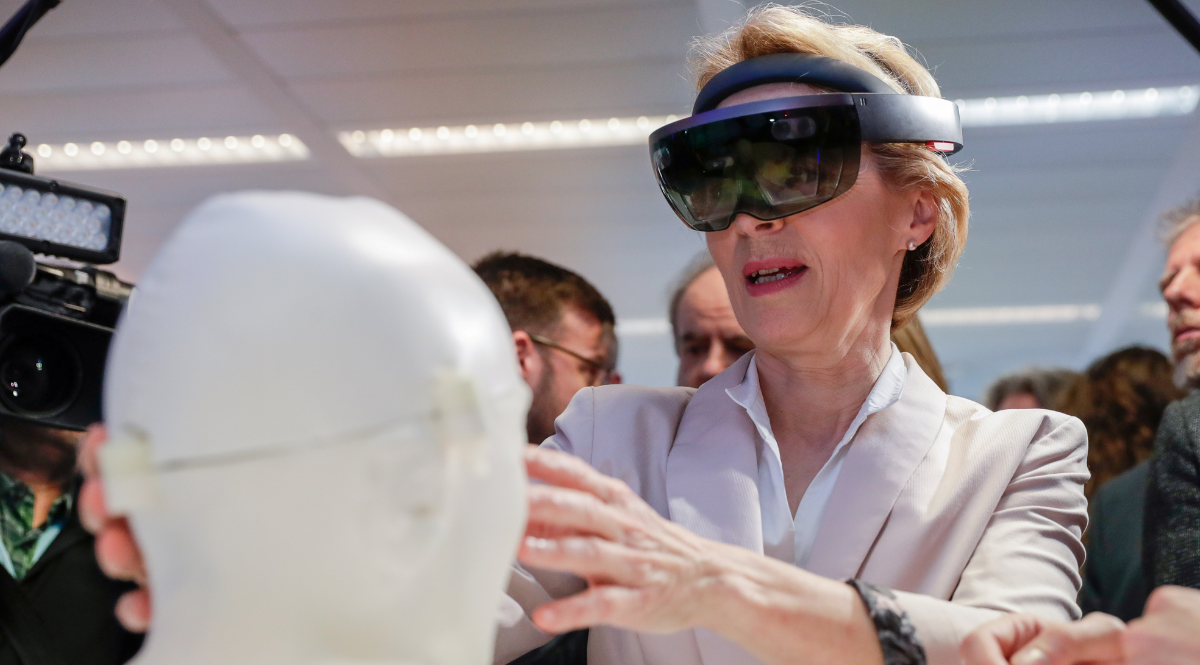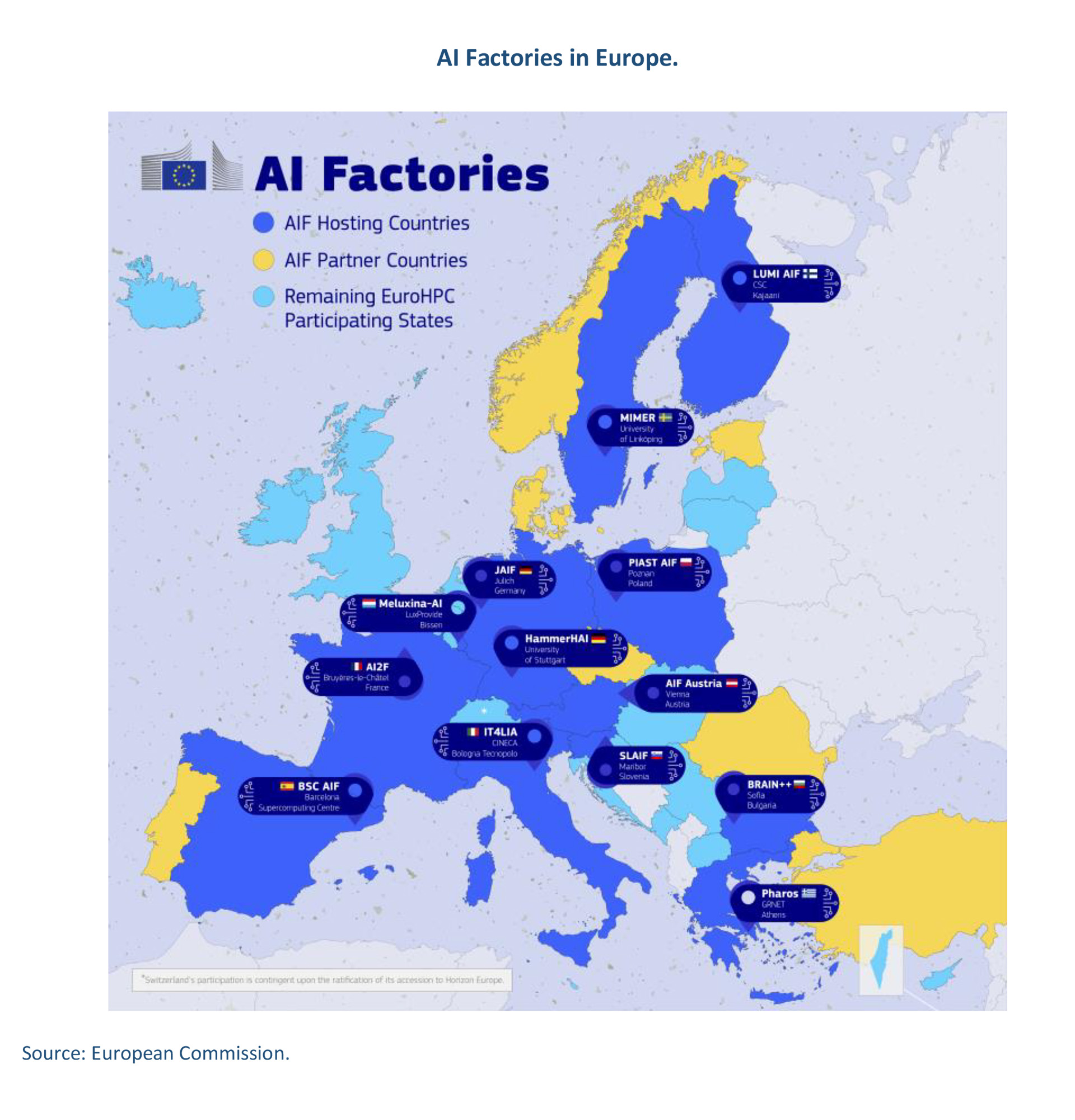European Commission Announces Action Plan for an "AI Continent"
On 9 April, the European Commission (EC) announced its AI Continent Action Plan. This new strategy for the development of artificial intelligence is intended to ensure the competitiveness of the European Union’s economy and the security and technological sovereignty of its Member States. The plan suggests that the EC sees the EU as a potential leader in the global race to create artificial general intelligence (AGI). However, the plan is unlikely to lead to an increase in the EU’s competitiveness in the AI market because it refers to the Commission’s previous AI initiatives without offering any new groundbreaking solutions.
 POOL / Reuters / Forum
POOL / Reuters / Forum
The AI Continent Action Plan is a strategic document presented by the European Commission on its own initiative. The vision proposed by the EC is for the EU to become a global leader in AI, offering solutions competitive with those developed in the U.S. or China. The plan was developed under the guidance of Henna Virkkunen, EC vice-president for Technological Sovereignty, Security and Democracy. Although some foreshadowing of this initiative could already be seen in EC President Ursula von der Leyen’s July 2024 exposé, this initiative stems primarily from the urgent need to strengthen European competitiveness, as pointed out in the Draghi Report and the Competitiveness Compass, among others. However, the immediate reason it emerged now is the presidency of Donald Trump, who wants to consolidate the U.S. position as the leader in AI through deregulation, also at the international level. The first indication that the EU might take steps to develop its own concept for AI development was in von der Leyen's speech in February this year at the Paris AI Action Summit, an international event jointly organised by French President Emmanuel Macron and Indian Prime Minister Narendra Modi.
The EU’s Strategy for AI Development
The EC’s proposed plan is based on five pillars. The first concerns the construction of AI “factories”, which are specialised data centres for training artificial intelligence, and, as signalled at the AI Action Summit, five so-called gigafactories, for which around €20 billion is to be allocated. These funds will come from the €200 billion special Invest AI fund that the EC announced in February this year. The second pillar focuses on increasing the availability of data for AI. This is crucial because generative AI models (i.e., those that create something relatively new from existing data, such as images or text, e.g., ChatGPT) are trained on large datasets, so being able to use such databases could make it easier for smaller companies to create AI solutions. Here, however, the plan does not introduce new solutions. It only refers to previously announced projects, including the Data Union Strategy (DUS), which the EU planned for the end of 2025 to strengthen AI innovation by increasing access to high quality, selected data across industries. A public consultation period on the DUS is due to open in the second quarter of 2025.
In the third pillar of the new plan, the Commission advocates the uptake of AI solutions in key market sectors, in particular security, agri-food production, and the automotive and pharmaceutical industries. By 2024, around 13.5% of companies in the EU were using AI, while the Commission’s goal is to increase this number dramatically. However, the strategy lacks specific quantitative targets and there is no information on how or why companies (including SMEs) would use AI models. The plan also focuses on education, its fourth pillar. Competence in this area is to be strengthened on a number of levels, from basic education to investment in research and science, to upskilling the workforce. The fifth pillar is the simplification of regulation. This is a response to the argument expressed by technology companies (but also widely described in the Draghi report) that current legislation is a barrier to innovation and competitiveness. Again, the plan does not introduce new solutions but merely highlights existing projects, such as the 2024 AI Pact, to improve the readability of legislation.
Data Centres and AI Factories
Data centres are specialised facilities that house servers, network equipment, and broad IT infrastructure. Among other things, they are used to process, store, and transfer large amounts of data. AI factories are a specific type of data centre, with highly specialised technology infrastructure and equipped with thousands of graphic processing units (GPUs), optimised to process massive datasets and engage in intensive computing, thus enabling the creation, training, and deployment of large-scale artificial intelligence models. In the AI Continent Plan, the EC envisages strengthening Europe’s network of High-Performance Computing (HPC) systems, which are composed of computers combined into a single large supercomputer for complex and advanced computing, precisely by building AI factories. There are to be 13 AI factories in the 12 countries that have been selected for the EuroHPC project in 2024, including Poland (see Fig. 1). The project operates on the basis of grants to research consortia, which then are to focus on data in key sectors, including health, the environment, and security and dual-use technologies.
The Commission also envisages an investment of €200 billion for so-called AI gigafactories. These are to be even more advanced data centres, with very high computing power, described in the document as “in excess of 100,000 advanced AI processors”—a total of five are to be built in EU countries. The plan suggests that the Commission sees the EU as a potential leader in the race to create AGI, or algorithms with a level of intelligence equal to that of humans, which would match or surpass human capabilities in most tasks. However, the creation of AGI raises ethical questions. So does the construction of the “gigafactories” themselves, as they would consume vast resources of water and electricity, which may conflict with other EU plans, including the goal of climate neutrality. Although the plan reflects on the energy needed for its implementation, it is only focused on the planned Roadmap to Digitalisation and AI in the energy sector. Climate issues do not appear in the plan at all.
Perspectives
The action plan proposed by the European Commission operates at a high level of generality and refers to existing initiatives while announcing a broad public consultation in 2025. For the most part, it also does not include new solutions, instead summarising existing regulations such as the Artificial Intelligence Act or the AI Innovation Package of 2024 in a coherent narrative. To some extent, however, it is a coherent strategic vision. The EU is determined to avoid fragmentation of its single market, which U.S. restrictions on AI chip imports could lead to, for example. The EC also wants the EU to reduce its dependence on critical technologies produced in other countries, including the U.S. and China. Again, the EC plans to increase the EU’s computing capacity (through the development of the cloud and advanced data centres) because dependence on infrastructure outside the EU can be a threat to the single market and economic security. The EU’s technological sovereignty is becoming increasingly important as uncertainty in markets related to Trump’s policies increases, as well as his plans to move semiconductor production to the U.S.
The Commission anticipates that the development of European AI will allow the EU to increase its competitiveness. The planned activities are intended to provide companies with the resources needed to build innovative solutions. While some of the assumptions presented in the document as a common strategy may indeed facilitate the building of generative AI models, the plan does not address other types of AI, such as those that facilitate decision-making or analytics, investment in which should be a priority for the EU. It also omits the more precise types of AI, created from less high-quality data. So while the implementation of the plan may indeed facilitate the development of AI models in the EU, it will not necessarily enhance European competitiveness. In addition, the plan is not consistent with other EU policies, such as the Clean Industry Pact, which may be an obstacle to its effective implementation. There is also no reference to EU security, and with increasing digitalisation, investment should be made in advanced security systems. A key focus for the EU should be the security of data and systems that will use AI, so that new developments are actually an opportunity and not a potential threat.



